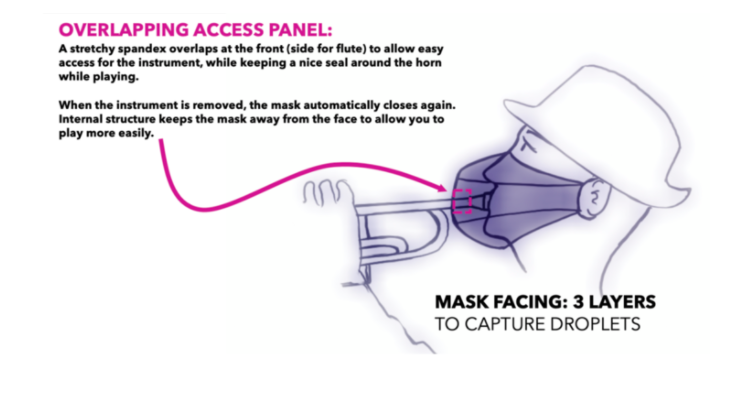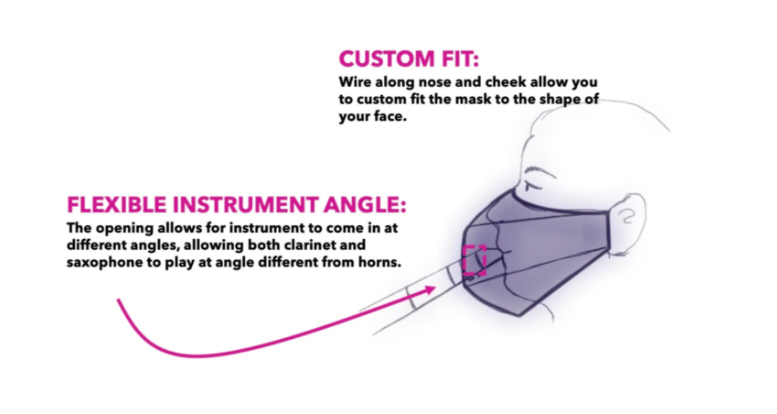For the Songbirds: Masks and Performance for Singers and Musicians
written by Miranda Allegar - September 11, 2020
Singing remains an incredibly high risk activity amidst the COVID-19 pandemic. However, research continues, pushing forward our understanding of what makes singing dangerous and how we can make it safer, of vital interest for many performers displaced over the last five months.
The danger of singing for viral transmission is evidenced by the early super-spreading events among choirs. The spread came as a surprise to very few, given both the understanding of the transmission of the coronavirus and of the particles transmitted from one’s mouth while singing. As a July 2nd article entitled “Safer Singing During the SARS-CoV-2 Pandemic: What We Know and What We Don’t” details, any vocalization can create respiratory particles, exuded in each exhale. Yet, the specifics of disease transmission through the act of singing itself remain uncertain—transmission rates may be due to the proximity and close personal interaction that the act often entails. The researchers go on to detail the varying levels of risk associated with singing right now, ranked by exposure length and viral load. Auditions and remote rehearsals are considered low risk, while vocal lessons, small group rehearsals and solo performances fall into an intermediate category. The highest risk category remains group performance in front of an audience and large group rehearsals. Yet, the article concludes on a hopeful note, anticipating the role of PPE, or personal protective gear. The authors note the potential benefits of fans, ventilation, distanced singing, outdoor performance and rehearsal, and even dividers. However, the mask remains the most common defense against the virus. But the mask as we commonly know it hardly lends itself to vocal performance, pressed tight against one’s mouth by necessity. What might a better mask look like?
One of the stranger rabbit holes that pandemic-centered media has introduced me to has been that of the specialty mask created for performers. I first encountered the trend on popular social media app, TikTok, where college students in performance majors showed off the rather distinctive face coverings they’d been asked to buy by their university programs. Overwhelmingly, I was struck by the similarity between the masks and the duck-themed kazoo I’d gotten as a party favor as a child.
Some quick Internet research helped me identify the product: the Singer’s Mask, sold through the Broadway Relief Project. The mask differs from its conventional counterpart in its stylized frame, constructed to hold the fabric at a distance from the wearer’s mouth, allowing more movement and resonance while still serving the vital purpose of preventing aerosolized viral transmission. The site includes earnest testimonial and video proof of the vocals possible with this mask. If the videos are to be believed, this variation on the mask might be the appropriate work around for the foreseeable future, though the risks of mass gathering associated with live performance still raise concern.
Even more delightfully, this site led me to the Instrumentalist’s Mask, also sold through the Broadway Relief Project, but this time featuring a small spandex access panel through which to insert an instrument and play while masked. As much as the masks themselves might inspire giggles, their functionality and innovation excites, giving a way to at the very least allow performers to maintain a regular practice and instruction without leaving public health guidelines to the wayside.
In short, vocal performance may need not be entirely set aside for the duration of the pandemic. Safer practice and performance protocols may be put in place and continually evolved to keep up with current public health guidelines and regulations. Inventions like the Singer’s and Instrumentalist’s Mask will surely continue as the pandemic remains a part of our lives for the foreseeable future, and as our fundamental goal must remain the good of the communities of which we belong to. As creators, the way forward must be imaginative and practical, aware of our reality even as we continue to create pathways to alternative realities through our art.
ISDP does not recommend or endorse products or practices advertised for safety. Rather, we hope to chronicle new measures in the field as they occur.



